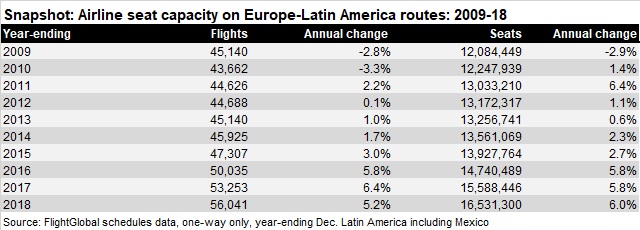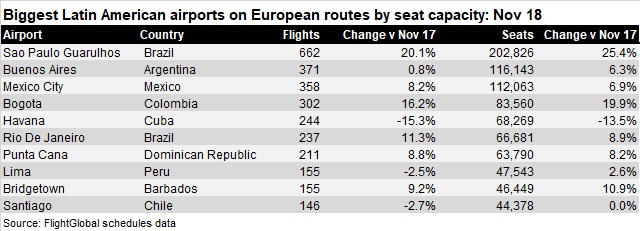European carriers continue to expand their networks into Latin America, with further routes for 2019 already unveiled.
Air France in September announced plans for its new sister carrier, Joon, to begin services next summer to Quito in Ecuador. It will operate the route thrice weekly using Airbus A340s.
Its SkyTeam partner, Air Europa, had in August detailed plans to launch a Panama City service from Madrid. The airline will operate the flights five times a week using Boeing 787s from 25 February 2019.
Norwegian, having launched its first South American destination earlier this year in starting London Gatwick-Buenos Aires, has further routes planned. The airline's chief executive Bjorn Kjos told FlightGlobal in September that the airline plans to launch flights to Rio using Boeing 787s.
FlightGlobal schedules data shows that airlines are set to increase seat capacity between Europe and Latin America, including Mexico, by 6.0% across this year.
That would mark the third year in a row where capacity between the two regions has increased at a rate of around 6%. This rate is more than double the capacity growth among airlines in any other year in the past decade – aside from the 6.4% capacity expansion of 2011.
Much of this year's capacity expansion is set to happen in the final quarter. FlightGlobal schedules data for November, for example, shows capacity between Europe and Latin America up by around 10% versus the same month in the previous year.
Latin American carriers have made their contribution to this growth. For instance, in September, LATAM Airlines began a service from Sao Paulo Guarulhos to the Portuguese capital, Lisbon.
But European carriers still account for around four-fifths of ASK capacity on routes between the two regions and far outnumber their Latin American counterparts in terms of operators in the market.
BIGGEST PLAYERS
Spanish carrier Iberia remains the largest airline in terms of seat capacity in the Europe-Latin America market. It has increased capacity by almost 15% compared with November 2017.

That includes raised frequencies on its flights to Buenos Aires, which it serves from Madrid, as well as on services from the Spanish capital to Mexico City and Santiago, and the restoration of direct services to Caracas. Its sister airline, Level, dropped its Barcelona service to Punta Cana in the Dominican Republic this summer, however.
Partners Air France and KLM are the next biggest operators in the market. Increased capacity from the French carrier includes restoring direct links to St Maarten, increased frequencies to Rio and the start of service by sister carrier Joon to another Brazilian city, Fortaleza. KLM also began serving the latter, as well as increasing flights to Aruba, but both carriers have reduced capacity to Cuba.
Air Europa has added Recife in Brazil and Quito to its network in the past year – the latter Ecuadorian route replacing its previous link to Guayaquil. Overall, the Spanish carrier's seat capacity is around 10% higher in November than the same month in 2017.
TAP Air Portugal's main focus has been on lifting capacity to Sao Paulo Guarulhos, where it links with its equity partner Azul, while its Star Alliance partner Lufthansa began services to San Jose in Costa Rica this summer.
KEY POINTS
Spain and Brazil remain to the two largest points for airline capacity between the two regions. FlightGlobal schedules data for November shows Madrid is linked to 26 points across Latin America. Airlines cut capacity on just five of these in the past year and overall airline seat capacity is almost 14% higher than in November 2017.

While Air Europa's Recife service is the only new destination added from Madrid to Latin America over the past year, capacity has been lifted on most routes in the region. That includes double-digit increases in capacity on the three biggest destinations from Madrid – Buenos Aires, Bogota and Mexico City.
Interestingly, capacity has also increased from Madrid on services to Caracas, notably with the launch of flights by Plus Ultra on the route. This is in stark contrast to the reduced international capacity into Venezuela amid its economic challenges, notably concerning foreign airlines recovering revenues earned in local currency. Overall, international capacity into Venezuela will fall for a fifth year in a row – and stands at roughly one-third of the level in 2013.
Meanwhile, airlines have lifted seat capacity on European routes from Sao Paulo Guarulhos by one-quarter over the past year. That includes new LATAM Airlines services to Rome Fiumicino, in addition to its recently launched Lisbon service.

Havana is alone among the 10 biggest Latin American airports for European services by seat capacity in November to see a reduction in service. Seat capacity is down 13.5%, partly driven by Austrian cutting its service, while both Air France and KLM have reduced their capacity into Havana, though still retaining daily and five-times-weekly service respectively to the Cuban capital.
Madrid accounts for five of the eight biggest routes between the two regions by seat capacity, November schedules data shows. Paris Orly connections to Pointe-a-Pitre and Fort de France in the French-administered territories of Guadeloupe and Martinique, together with a London-Gatwick link to Bridgetown in Barbados, are the biggest routes besides Madrid.

MARKET DISRUPTION
Low-cost long-haul operators are playing a growing role in this market from the European side. Network carriers IAG and Lufthansa have both deployed Level and Eurowings on routes in the region, while Air France-KLM has turned to its new millennial-focused Joon operation.
Norwegian, which on top of its Buenos Aires route is soon launching its own Argentinean subsidiary, sees further growth in and to South America. The carrier is looking at basing some of its Airbus A321LRs, which begin arriving in late 2019, in Argentina to serve international routes within the continent, says Kjos.
The carrier is also looking at connecting some of its long-haul bases in southern Europe, for example Barcelona and Madrid, to South America, notes Kjos, adding that there is a lot of "flow" between these markets.
"It's extremely expensive to fly on some of the routes there," he says. "They deserve to pay lower fares."
Gulf carrier Emirates had also been poised to begin a Barcelona connection to Mexico City utilising fifth-freedom flying rights. The move prompted Aeromexico to abandon its own plans to launch a Barcelona service this November.
Emirates has, however, now dropped the planned route, which would have connected to Dubai through the Spanish city, after failing to secure slots to operate it daily.
"Despite previous assurances that slots [at Mexico City airport] were not an issue at the flight timings requested, the Mexican authorities have informed us that we will not be able to operate daily services, but only three flights a week," says Emirates.
"Unfortunately, this is not commercially viable for us, given the resource investment required for such a long-distance operation, not to mention the negative impact on connectivity and convenience for our customers."
Aeromexico had argued that Emirates' fifth-freedom authorisation on the routing would allow it to "offer flights between Mexico and Spain as if it were a Mexican airline".
Emirates says it hopes to serve Mexico in the future when "the conditions enable us to do so", while Aeromexico has since stated that it intends to revive plans for the route, without confirming a timeline.
Article updated on 17 October to update data in table Biggest airlines on Europe-Latin America routes by seat capacity Nov 18, and corrects Emirates/Aeromexico planned route Mexico City route is from Barcelona.
Source: Cirium Dashboard


























